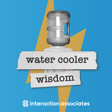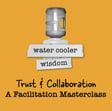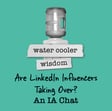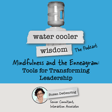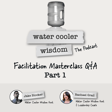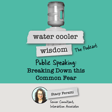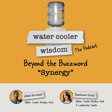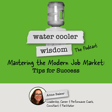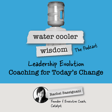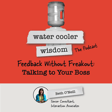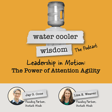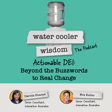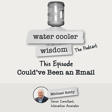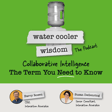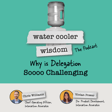The Challenge of Engaging Meetings
00:00:10
Speaker
Keeping a meeting on track and participants engaged is a constant struggle for anyone that finds themselves leading or facilitating meetings. If you're looking for new ideas to overcome these challenges, we might just have something for you.
Introduction to Visual Facilitation with Rachel Thompson
00:00:23
Speaker
On today's episode of Water Cooler Wisdom, we'll answer the world of visual facilitation with our expert guest Rachel Thompson from Daring Studios. Rachel, a certified wizard at turning complex dialogue into captivating visuals,
00:00:37
Speaker
helps us understand how a simple shift to drawing and imagery can recapture attention and improve your meetings. This episode will aim to guide you through this innovative approach that promises to add a new dimension to your meetings.
Hosts Introduction
00:00:53
Speaker
Welcome to water cooler wisdom. I am Jake Blocker. And I am Rachel Graham.
00:00:59
Speaker
Rachel, how are you doing? What's new with you? I'm doing great. I'm so happy to be here. I'm excited about our topic today. We'll get to that in
Rachel's Australia Trip Experience
00:01:08
Speaker
a minute. I want first to hear about your recent trip to Australia. You just got back.
00:01:14
Speaker
Yes. Yes. It was an amazing trip. It was a little bit of a last minute thing to do. I mean, kind of last minute going to Australia, just fortunate, but yeah, it was absolutely beautiful. Spent a little time at Sydney, went to an opera at the Sydney Opera House and went to, went to Bondi Beach. It's summer there. So it's just warm and perfect. I was leaving the Denver weather everywhere.
00:01:38
Speaker
Oh yeah. Beautiful people everywhere. I just feel like a mortal amongst gods when I'm in Australia, but just gorgeous people everywhere. And, uh, yeah, it was super cold in Denver when I left like negative Fahrenheit degrees, negative, uh, also Celsius degrees, negative, I guess, but miserably cold. So it was nice to escape and be in beautiful Australia, which you're, you live there for a little bit, right? I did. I lived there for a year when I was younger.
00:02:07
Speaker
He's doing work with NGOs. That's a story for another time. Yes. Yeah. Yeah. It's a beautiful place. I was there for a week, maybe a little over a week, and I feel like, man, I wish I could be there longer. It's just so gorgeous and nice. Well, I'm glad that you decided to come back to us and didn't just cut and run forever.
00:02:32
Speaker
It's nice to have you back. And now you're back in the land of meetings as I am.
Who is Rachel Thompson?
00:02:37
Speaker
We've been in lots of meetings. And I think that's maybe the right segue for our topic because I'm so excited for our guests today. We have Rachel Thompson, who is going to come in and talk to us about visual facilitation. And really, it's a new way of thinking in meetings about how do we get the most out of the ideas that are shared. So I'm excited.
00:02:59
Speaker
Great, let's dive in. Rachel Thompson works as a visual facilitator, business strategist, and human-centered designer, coach, and consultant at our company, Daring Studios. She's a certified professional facilitator through International Association of Facilitators
00:03:17
Speaker
and co-organizes the Nova Scribes Meetup, a free community of visual practitioners. You can find her online at daringstudios.com and at Rachel The Daring on social media platforms. We're so excited to have her here today. Yes, yes, welcome Rachel. How are you doing today? I'm good. Thank you so much for having me. I'm very excited to be here. Yes, yes, thank you. Yeah, we're fortunate to have you today to discuss
00:03:44
Speaker
Visual facilitation, meeting facilitation is something that's really near and dear to the hearts of us interaction associates as you can imagine. Our facilitation training is something we're really well known for. Insert sales plug here, something, something, check this out. I'm not a salesperson, I'm sorry, this is why I'm in marketing.
00:04:07
Speaker
Usually when we speak about facilitation, it's mostly around the standard definition of training with some visual elements as well. But it's ultimately what people imagine as a mini facilitator. So it's a meeting working through an agenda. It's keeping people focused and engaged in meetings.
00:04:25
Speaker
ultimately leading them to their actual next steps. So I'm excited to learn a little bit more about visual facilitation.
What is Visual Facilitation?
00:04:32
Speaker
So to start us off, I'd love if you can just speak a little bit more about what visual facilitation is and maybe provide some examples. Yeah, so visual facilitation really is facilitation. We're using visuals to help move people through the process.
00:04:48
Speaker
and maybe even the room. So one thing I like to think about it, like if you're in a meeting, especially like a, imagine you're in like a kind of a conference room with, I don't know, 20 people having conversation and you just use the walls, there might be a whiteboard and people might stand up and go up to the whiteboard to draw out, oh, this is what I mean. But if you use it more intentionally, you can use the room as an agenda. That's one term I like to use. And use like put up papers or graphics or templates
00:05:16
Speaker
around the room to be like, okay, here's the agenda, like an ORS chart, the outcome, the agenda agreements and roles to really orient people to the day. You can use that and you can have that up there the whole day or the whole meeting and people can refer back to it and be like, okay, where are we? Where are we going? What's next? And then as the conversations build throughout the day, you can then capture in the morning, maybe we're having a conversation around
00:05:38
Speaker
strategic planning and you can create a chart like a big big template on big four-foot rolls of paper which you can find put on the wall and then capture people's ideas and visual facilitation is really using visuals and by visuals I mean sometimes it's templates sometimes it's icons
00:05:57
Speaker
Sometimes it's just using just words in a hierarchical way so that these things are more important or just a way to add visual hierarchy to the meaning and the layers of the conversation. You can use visuals in that way to really add meaning to the whole conversation. And then later in the afternoon, if you can point back to something, like this morning, remember this conversation? You can look at this thing on the wall over here. This is what we talked about. This is what we agreed on.
00:06:26
Speaker
So it's really nice to use that as a way to kind of move people through a process in a way that's visual, because it creates a visual anchor that people can then look back at either later in the day or like three weeks later, they're like, what did we talked about that thing? But what did we say? And what did we agree upon? Oh, that person, we wrote it on the wall, we can look back. Oh, I remember that guy said this, that lady said this. That's what we talked about. Let's move forward.
00:06:52
Speaker
But I think of, I think of our workshops, like our public workshops I've attended and the, you know, we have our butcher paper that is all around the room by day three. You were just surrounded by so much paper, but it makes such an impact just being able to, for, you know, Rachel and she's leading a workshop to point and say, all right, now we're here. And it's, it doesn't take a long time to gather people back up and remind us where they were. Cause you, that visual cue of, oh, yup, there it is. We're good. Let's go.
00:07:20
Speaker
Right, that was my thought too, this idea of a visual anchor, something that people can come back to. And this really connects a bit to my next question, which is that we know a big challenge people face in meetings is keeping the focus or regaining the focus after it's lost. And that can have a huge impact on the level of productivity, on what we can really achieve. So how does visual facilitation maybe help that challenge?
How to Keep Meetings Engaged with Visuals
00:07:47
Speaker
I mean, it really does. I think one way it does is there's a couple ways you can do it. You can have the big communal chart on the wall. You can also do some table templates, like pass out templates or things. People can write their notes visually for themselves in a way that can be shareable. And then sketch noting is another term that is often used. There's some language in this.
00:08:11
Speaker
in the visual facilitator field or the visual practitioner field, visual practitioner, visual facilitator, graphic recorder, or sketch noter. And there's different nuances depending on what people want. But sketch noting is really what I say as it's like taking notes for yourself, but in a visual way. And that's something that even if you start doing that for yourself, because you're using visuals to help capture the conversation and your ideas. And it's something you can share easily. And it helps you think through it
00:08:40
Speaker
the act of writing it down, you're processing the information, you're synthesizing the information, and you're really listening for the things that are important and may be meaningful or that are takeaways or actions, and that's what you're capturing. You're not a stenographer. You're not capturing the whole transcript. There's AI for that. We don't need to do that.
00:09:02
Speaker
But the translation of listening to a whole story or whole conversation, be like that thing. That's the insight I want to capture and write down and then share out. And then just the act of having the medium to write, the medium to share and do it in a visual way.
00:09:22
Speaker
It just helps focus because you're listening for the thing to write down. You're not listening to all of it. And so your mind's a little bit more primed, but you're also not trying to capture all the things. You're tuning it a little bit. You're dialing it a little bit, and it's really helpful to help with engagement. Right, seeing here's the main point. It's like the highlight in our minds happening in front of us visually. Love that.
00:09:47
Speaker
Yeah, I take myself back to college days of taking notes, and I'd say most of my notes were doodles. Maybe it speaks to my graph design because we passed, but it did help me. It was like, as I was kind of doodling and taking notes here and there and coloring the words, I was remembering. It was so much easier to remember versus, all right, I got to hurry up and write all these notes. I miss something.
00:10:10
Speaker
Yeah, and I think there's some research out there. I don't know for sure, but you know, thinking about we often equate like eye contact with listening. We listen with our ears, not with our eyes. But we can communicate things with our eyes, you know, even like across the room and things. But like for the listening and the engaging part,
00:10:29
Speaker
I think also a lot of autistic people have tended to be, this is very general, but maybe more doodling. And just in general, I think humans, when you're engaged and your hands are engaged in some way, you're processing, you're thinking through it. So doodling, even in the margins, it's a different way of listening, which I really like that perspective shift of
00:10:51
Speaker
it's a way to listen. And it is like, I agree, like my college notes, I was very much a note taker because that's how I process information. And really visual note taking or sketch noting, if you want to Google it, there's tons of resources, is a way to just amp that up and to build some skills around how to do it with more clarity and more like more composition. And so you're actually writing a lot less, but maybe remembering a lot more, which is really nice.
00:11:21
Speaker
Yeah, I think I've seen some of that research too and it's something for me at least it was shutting down the rest of the brain that was just thinking of all the hundred other things going on in my life and in the room and oh, that girl is wearing this and oh, I see a green shirt. So I was able to just focus on the paper in front of me. It was a little doodle. I'm actually hearing versus the green shirt over there.
00:11:46
Speaker
Yeah. And there's something very inclusive about it too, because we know that people take an information in different ways. And so having another way to convey that information, I think is really a wonderful addition. Yeah. Yeah. Absolutely.
00:12:04
Speaker
So what, what may be some entry barriers that you've noticed that might, might make people feel a little apprehensive. I imagine, you know, I think of myself in Pictionary, for example, I will think since I have a graph designer past, I am the best.
00:12:20
Speaker
Yeah, they think I'm just the best. I can draw anything and they are severely disappointed whenever they actually start playing with me and how absolutely dreadful I am. So I can imagine some people may think, Oh God. Yeah. No, I think the two things that people often say is I can't draw or my handwriting is horrible.
00:12:40
Speaker
Yes. And those are things like, I mean, one concept is like, if you believe you can't draw, then you probably can't draw. But also you can just like, you just haven't learned how to draw like ever, you can put a pen to a paper, you can do a circle, a line, a square, a triangle, you can create a house and create a tree, like just using basic geometric shapes, which pretty much everyone, I mean, unless you're
00:13:05
Speaker
have some sort of circumstantial thing, can do that, right? Star people, like there's very simple things you can do. And then the handwriting is also one, but like both of those are things that you can actually improve. You can like, I've done a lot, you can do a lot of training just like thinking about your writing and just practicing it so that when you're writing quickly,
00:13:26
Speaker
just you think about you learn some tricks like how to write big on a wall and one of them is like keeping your hand in front of you so if you're writing a long sentence you like you move your body you move your body so that you keep it in front of you so you're not trying to write and you end up writing down and stuff like that but there's just lots of tricks in practice but yeah so i can't draw as one but really breaking it down to
00:13:49
Speaker
You don't need to draw very complicated things. A circle with a couple lines, you can get a sign. A line with a circle on the top, that's a tree or a lollipop. And if you draw something, and no one knows what it is, arrow, label it. This will be in here? Spider. This will be in here? I don't know, a storm cloud. Just letting that go a little bit.
00:14:13
Speaker
It's really easy. And another trick is you don't even have to use pictures at all. One way to really use visuals is to think about, we do this a lot of times with word documents. It's like the bold header is larger, a larger font, maybe fewer words. The sub header is a little bit smaller, but it's still a couple of senses. And then you have the font or the hand of the paragraph.
00:14:37
Speaker
You can use that same structure in your visual notes and on the walls and things like that, just making the more important things larger and bolder and then using that sort of the natural things we tend to do maybe digitally, you can apply the same thing to the handwritten notes or to templates or things on the wall too. So that's two things that are really helpful.
00:15:02
Speaker
It sounds like this is just a way of thinking differently, too, in how we convey information and allowing ourselves to get a little bit creative. And how am I thinking about this? And how do I convey that individual manner? So you just shared some really great tips that I thought were super helpful. Are there other tips or like low risk ways or low risk approaches that people can start taking on and find out more about to try this out?
00:15:31
Speaker
No, one of my favorites is to turn a paper, like if you're taking no-speaper paper, we tend to do it like, what is it, portrait mode, going back to things. If you just turn it landscape mode, so it's on the side. So even that, that kind of moves our brain, you know, we're visual thinking in a different way because the structure of the paper actually can give structure to the conversation and to the way we think about it.
00:15:54
Speaker
So in a portrait mode, you tend to do lists or maybe outlines. It's very linear, top to bottom, maybe right to left, going down. You turn on its side to a landscape mode, and you just start in the center. You can make something called a mind map, which is one of my favorite things because the
00:16:15
Speaker
inherent structure of a mind map is less formal. Like you start in the middle, but maybe you want to brainstorm ideas for a podcast conversation. You start in the middle, just ideas, and then you can go out this way or you know, go out branches out to the sides.
00:16:31
Speaker
And you can just kind of go around. But it's not linear, because you're not giving importance to the first idea. You kind of can build around it, and then you can go back. Be like, oh, this idea gave me another idea, and you can add on to it. So it's a little bit more generative, but it's also a little bit looser. And it's very accessible, because most people can turn their piece of paper on the side and even really think about that differently. Like a lot of whiteboards and meetings are kind of that landscape mode.
00:16:56
Speaker
So if you just think about maybe starting in the center or just starting in the top right or top left or whichever, yeah, top left, I think that Americans tend to do that. Even just starting in a different place can switch your mindset and switch how you approach a topic.
Creative Brainstorming Techniques
00:17:12
Speaker
It can be very generative in that way. I love that idea. I'm gonna start doing that. And I think just kind of like giving little tricks to make our mind think in a fresh way. It's really fun.
00:17:24
Speaker
Yeah, I mean, that takes me back. When I've had some more of the creative discussions, it usually has been start in the middle and then we start branching out. And then there's some squares here. There's some circles here. And that's been all of us out here.
00:17:37
Speaker
Yeah, and I think another thing I might add there is that to not be precious with the paper. Like people tend to, like if you have a nice pretty piece of paper, just having that first mark. And one way to do that, honestly, is just to make a board around the outside. Because then it's not the neat paper anymore. Someone's made a mark on the paper. And then it's like it just opens up
00:17:57
Speaker
the floodgates. So you're not messing up the pretty paper. You're building a little bit of that. Okay, let's get a little bit messy here and have some fun. Right. Getting started is always the hardest part. I love that. Make a border. That's great. A little off script question here for you is what are maybe some virtual tips that you might have or some tip or two, because I'm sure a lot of people are doing hybrid or virtual meetings that they may be able to translate this
Adapting Visual Facilitation for Virtual Meetings
00:18:26
Speaker
Yeah, so I think virtual is a different challenge, but there's a lot of things out there that can help with this. You do have to have a little bit more tech up-leveling. You want to orient people to the tech and then to the process separately. Absolutely. And so there's something called mural. There's mural and mural, which are very close when you say them, but they're two digital whiteboards.
00:18:52
Speaker
that are nice that you can really use visuals to use that. And also, even if you do a PowerPoint, if you do a blank PowerPoint presentation, there is a draw feature on that. So if you have a touchpad or some sort of thing there, you can draw on them. Or you can just do a typing version using PowerPoint or things like that. And then the Google documents are those synchronous documents. You can use those to creating a visual template that
00:19:21
Speaker
you know, Google documents you can to turn landscape mode. And even that kind of it's a little bit different, but it still gets your brain going. And that's another way to do that. So just like using the tools you already have and just thinking about how might you make this a little bit more visual, make this a little bit more interactive, make this a little bit more
00:19:41
Speaker
capturing the conversation in some sort of visual way that people can see it and react to it. Another cool thing about visual facilitation is, especially if there's a disagreement, you can put it on a piece of paper and then I'm not arguing with you about this thing. I'm arguing with the wall kind of about that thing, about the piece of paper, about the idea, right?
00:20:02
Speaker
not the person. It's us against the issue and the issue is over there and we're here together figuring it out. Making it visual in that separate place moves the focus from the person to the issue and just that visual cue is really helpful to change group dynamics and just have a more productive conversation.
00:20:26
Speaker
I hadn't even thought of it that way. That's really cool. Instead of yelling at one another to their face, I'll yell at this piece of paper. Not that we ever do that, though. No, never. No, that never happens in meetings.
00:20:39
Speaker
Yeah, yeah. A shout out to Mural too, the one with the L, not Mural. Yeah, Mural's a, we use that on occasion. So I'm brainstorming some planning since we're all remote. We'll sometimes start there, or if we meet in person, we'll move our ideas over to that and then use that as our shared space. And then they also have like a ton of templates that are built in to, to the system that are super helpful. But yeah, and Zoom has, I think Zoom is trying to compete with that too right now.
00:21:09
Speaker
Yeah, I've actually used mural to design a template that I then print and put on a wall because it's, I mean, I don't want to, sometimes it's easier to do it in like a, like an Adobe software or something, but honestly, sometimes it's easy to just go into mural and they have like the blocks and stuff there. So maybe a cool tool for that too.
00:21:27
Speaker
Yeah, I love that. Well, so for so many new, cool tools, there's also the flip side of sometimes you don't need to use it.
When Not to Use Visual Facilitation
00:21:35
Speaker
Sometimes it may be too much. We were talking about collaboration on one of our last ones where we said collaboration is amazing, but sometimes it's not necessary. So with this, are there some circumstances where maybe you shouldn't do visual facilitation?
00:21:49
Speaker
Yeah, I think that, especially if it's a confidential or sensitive conversation, where maybe people don't want to have any sort of record, because you want to create a safe space. That might be a situation where you don't want to write anything down, really.
00:22:09
Speaker
you're really listening and you're dialing into, like if there's energy in the room or there's something going on in the room, sometimes it's helpful to write it down and get it out. But sometimes it's like you're really sinking into like the listening, reflecting conversation part. And so it's nuances there.
00:22:26
Speaker
Another kind of flip side of that question though is sometimes using visualization facilitation or using visuals can help flatten the hierarchy because it can be anonymous. So that's kind of a flip. Sometimes it's helpful to do it, but sometimes it's not.
00:22:42
Speaker
And then it is kind of thinking about accessibility. Who can see it? How many people are going to be there? How are you going to organize the information? What's the purpose? How are you going to align? How are you using the visuals or the templates or the facilitation to support the outcome? And if it's really like a conversation between peers, like peer coaching, maybe it's more about maybe you have the prompts visually, but then people are really listening
00:23:12
Speaker
and receiving and paying attention in that way. So it can be a little bit of a thing where you want to really connect it back to what's the outcome you're trying to do and how might it support that outcome and make progress towards it in a way that's helpful and meaningful and impactful.
00:23:30
Speaker
Yeah, that makes sense. That makes a lot of sense. And I think maybe even sometimes having one person that's guiding the conversation and another person that's capturing the visuals, if that's applicable. So absolutely. A lot of the things, especially when, if you're, so going back to kind of earlier, I mentioned graphic recording and like graphic facilitation, like some of these terms are intermixed between graphic
00:23:54
Speaker
recorder or visual facilitator graphic facilitator, but the facilitator part like you one person can facilitate and capture but that's
00:24:05
Speaker
Honestly, you have much messier handwriting that way because you're doing both at once. The graphic recording really is someone just listening and capturing. Their back is to the audience because they're listening and they're writing on a wall or something. So people can see what they're writing, but they're not really guiding the conversation. And really, sometimes it's really helpful to have two, like a facilitator and someone capturing. And often, going in pairs and then you can alternate between them.
00:24:35
Speaker
And I've done that before, definitely, where I've worked with a partner with a group. And for one section, I'll be capturing information, and they'll be facilitating, and then we'll flip, things like that. So that adds really interesting dynamics to the room. But it is having the dual people, I think, is very helpful as well. Yeah, and that way you get two perspectives of what the salient points are. These are just such great tools, and we're all about
00:25:02
Speaker
giving collaborative tools.
Resources for Learning Visual Facilitation
00:25:04
Speaker
So I'm so excited that we got a chance to hear a little bit about this. I'm excited to give it more of a try. I've done some of this, but I feel like you've given me some confidence to do a little bit more. And I'm hoping that maybe our listeners are feeling that way too. So perhaps you could share with them where people can find out more about you and more about visual facilitation if they're curious.
00:25:26
Speaker
Yeah, um, first I might recommend that a really good way to get started is to just do it, just start taking visual notes for yourself in meetings. Just piece of paper, you know, do the landscape mode, just start doing it. That's a really easy, low risk way to get into it. And then just getting up in front of people on the wall is it's a whole level, another level of things.
00:25:46
Speaker
doing it for yourself is really helpful. So a couple of resources. So I think as Rachel mentioned earlier, I'm one of the co-organizers for the Nova Scribes meetup group, which is it's a virtual community on meetups. So anyone can join for free. We do a lot of virtual
00:26:03
Speaker
events about different things kind of related to the visual practitioner community, things like that. There's also a conference called the International Forum of Visual Practitioners, which is like an association. They're having their conference in July. If you're interested, there's a community there. And then just there's a bunch of books. I know Brandy Agarback has some courses if you're wanting to actually learn how to do that. Emily Mills also has some kind of books and courses like for intro to sketchnoting or intro to graphic consultation.
00:26:32
Speaker
And Heather Martinez lets letter together. If you're interested in working on handwriting, which is, I think, a vulnerable area for a lot of people, but it's a skill you can build. You can learn how to write a very neat, basic hand so that when you're maybe facilitating, you don't have to think about it. You've practiced it itself. And so when you're in the moment, you're just writing.
00:26:56
Speaker
in a way that people can read from across the room and things like that. So those are just kind of in the community some resources that I really like and I've used and learned a lot from these people. And then I also just really interested in visual facilitation and all those things. So just through the Nova Scribes community definitely reach out to me. My name's Rachel Thompson, I'm there and you can always just email me if anybody's interested.
00:27:17
Speaker
Perfect. And we'll have all of those great resources linked wherever you've got this podcast. So don't worry if you weren't taking visual notes while she was sharing all of those states. But actually podcasts, the conversational podcasts are a great way to practice taking visual notes too. Oh, nice. I love that idea. Yes. No for our next ones, Rachel.
Rachel's Rapid Fire Q&A
00:27:40
Speaker
Well, before we let you go, we have to do a rapid fire. We've started doing this recently, and these are tough questions. I hope you're prepared. So buckle in. These are controversial questions, I think. I'm ready. All right. So first off, coffee or tea in the morning? Neither. I don't drink coffee or tea. Ooh. Impressive. That's a weird one. A lot of people cannot relate to that. What about early bird or night owl work style?
00:28:09
Speaker
Definitely not an early bird. I would say, honestly, afternoon is kind of my prime spot, and I tend to stay up a little bit late. Maybe not working late, but just up late.
00:28:21
Speaker
Yeah. Well, maybe if you had a coffee or tea, you would be, uh, Is that a thing I want to, I want to cultivate? What about this one's perfect for this topic, digital or handwritten for your to-do list? Um, I actually like handwritten for my most active to-do list, but then like digital for my kind of project management.
00:28:50
Speaker
Planning and organization. What about an app or platform or software that you swear by for your work? I actually like using Google Calendar as a visual planner for how I'm going to organize my time. It's a very visual way to think about project planning, my life, and all those things. So Google Calendar, for sure. And then Notion is another one that I've recently gotten into as far as for work.
00:29:18
Speaker
Gotcha. Are you like a calendar blocker? We will have blocks for every like minute. I don't do it minute by minute, but I definitely do track a lot of my time and in a very visual way. Cause it helps. I actually just did this yesterday for February. I said, okay, what are the different client projects I have and the other personal projects and what's going where, what adventures do I want to go on? Like all that stuff. I, I do use it to as a planning tool. Got it.
00:29:46
Speaker
What about a book that made a significant impact on you? I don't have books. A couple that I really liked are Essentialism by Greg McCowan. I've read that several years ago and just really liked that. A lot of Brene Brown's books, especially The Gifts of Perfession. She was out of my favorite stuff there. The Art of Gathering by Priya Parker, another one of my favorites.
00:30:16
Speaker
And then this is a little bit, a book called Apartment Therapy, which is like interior design, but kind of how do you create a space that is supportive? So it wasn't really interior design, but it was more like human centered design for interiors. I read that a while ago and I really liked that one too. Yeah. Love it. Love that. Check it out. What about a podcast or music for backgrounds while you work?
00:30:43
Speaker
I have a binaural, binaural, binaural, I never know the word. It's like, it's binaural beats. It's like a focus playlist on Spotify that has no words and I just like five or seven hours long. I just put it on, headphones on and I just go. Oh yeah, great. You have something going on, but it's not distracting.
00:31:04
Speaker
Yeah, it's very like focusing. It's like a cute, like a mental cue to myself that I'm moving into work mode and really, it's really lovely. I like podcasts when I'm walking. Yeah. What about your work environments? Prefer remotes or in person? I actually like both if they're intentional. Like if I'm doing deep work or meetings, I like working from home.
00:31:30
Speaker
if I'm wanting to collaborate and really connect with people and be social, then in person. So I like the distinction between, and sometimes parallel work with people is nice, but sometimes I've worked that, so if you go a co-working or you go into the office and you have the dual competing things of, are you trying to be social and connect with people and build relationships? Or are you trying to go deep on a project? Sometimes those are competing, so both and. Got it. That makes sense.
00:32:00
Speaker
So to bring it back home, bring it back to what we hold near and dear. So if you could have a water cooler chat with anyone dead or alive, who would it be and why? I feel like this is the most impossible question ever. Because there are so many people that I really enjoy talking to and just want to spend deep dives on. Actually, the challenge I have here is I feel like a water cooler chat
00:32:28
Speaker
Is shorter and i'm like no let's have like a three-hour conversation that's why my trouble is so water cooler chat i don't know maybe bernie brown i think she's someone i'm really would love to talk to her but i think about introverts so it's great yeah just bring a big water bottle and yeah just sip water for a while have a bathroom break and come back yeah.
Closing Remarks and Thanks
00:32:51
Speaker
I love that. It's been so fun to get to know you through those rapid fire questions and through this whole session. Thank you so much, Rachel, for coming and sharing so many great tips and ideas opening this new world to us and to our listeners. We appreciate having you here. Thank you for having me.
00:33:10
Speaker
Yes, thank you so much. And thank you to our listeners for being with us on Watercooler Wisdom as we find our way into our podcast. And don't forget to email us or reach out if you have ideas that you want to hear us chat about. We'd love to hear from you. Jake, always a pleasure to be with you as well. Yes, same to you. All right. Have a great day, everyone.
00:33:35
Speaker
Thanks for listening to Water Cooler Wisdom. This podcast is brought to you by Interaction Associates, a leading professional development and leadership training organization whose mission is to help people work better together. If you'd like to learn more, visit interactionassociates.com. If you have questions, comments, or are interested in collaborating with this podcast, you can email us at watercoolerwisdom at interactionassociates.com.

